Select Your Country
Selecting a different country will redirect you to that homepage.
United Kingdom
A structured, adaptable and repeatable approach to enable individuals to successfully move through changes in your organisation.
No video selected
Select a video type in the sidebar.

Technical side is executed by the project management discipline
Organisational change requires individuals to move from the current state to the future state—which requires managing both the technical side and people side of the change
People side is executed by the change management discipline

The Prosci Methodology is one of the most widely used approaches to change management in the world, and it continues to evolve. In response to practitioner feedback and changing customer needs, and to prepare for future change trends, Prosci refreshed the methodology in 2021. The updated Prosci Methodology is more actionable and accessible, and the enhancement will elevate client success in incredible ways.
Although the Prosci Methodology encompasses a variety of models, tools, assessments, processes and more, today it is comprised of three main components:
PCT Model – a simple but powerful framework for establishing and connecting the most important aspects of any successful change effort
ADKAR Model – a highly effective model for guiding individuals through the experiences—or elements—needed to make the change
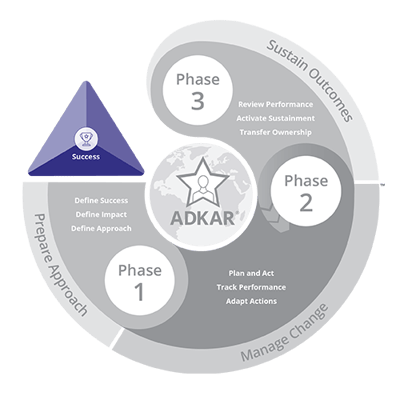
PCT Model
A framework that shows the four critical aspects of any successful change effort and how they are interrelated: namely, a shared definition of success with leadership/sponsorship, project management and change management.
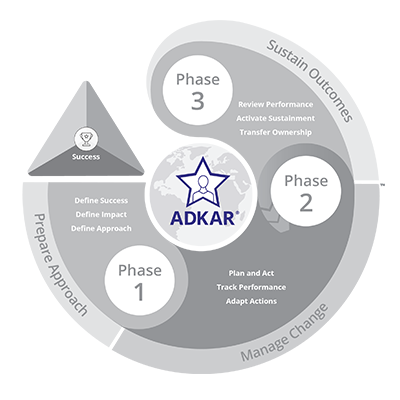
ADKAR Model
Describes the five building blocks or 'elements' an individual needs to achieve for a change to be successful. Impacted individual is at the centre of the Prosci Methodology. Individual success leads to organisational success.
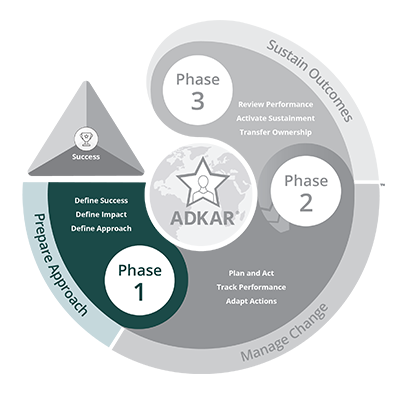
Phase 1 - Prepare Approach
Purpose: To position the change for success by developing a customised and scaled change management strategy with the necessary sponsorship and commitment.
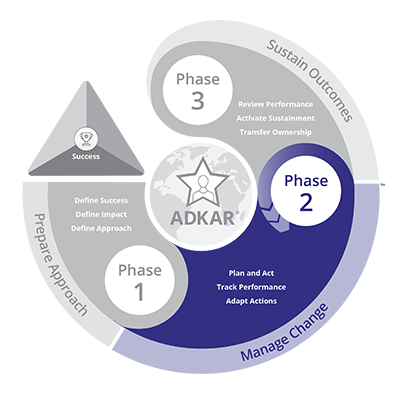
Phase 2 - Manage Change
Purpose: To achieve adoption and usage of the change by creating, implementing and adapting plan(s) that will move individuals and the organisation through ADKAR transitions.
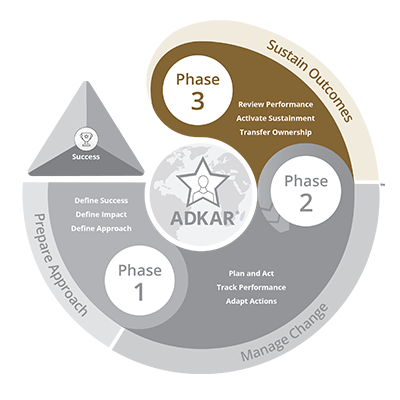
Phase 3 - Sustain Outcomes
Purpose: To realise the value of the change by ensuring the change is adopted and the organisation is committed and prepared to sustain the change.

The success of any organisational change depends on the success of change management in encouraging individuals to embrace, adopt and utilise a required change. The change management methodology itself must be structured enough to be repeatable, but also flexible enough to meet the needs of any organisation. That’s the Prosci Methodology:
"I did not realise how critical it is to do effective change management. I did not realise how much work actually goes into coaching and bringing about change.
- Chantal Oliver, Oxford University Press

The Prosci Methodology enables organisations to manage change wisely. By doing so, it helps employees thrive through the changes they’re faced with and increases the returns on project investments.
You can learn how to apply the Prosci Methodology to change initiatives in your organisation and become a Prosci Certified Change Practitioner by attending Prosci’s Change Management Certification Programme. It’s an engaging, energising 3-day learning experience that gives you the knowledge, tools and skills you need to successfully drive change in your organisation.
Once certified, you’ll have anytime, anywhere access via the Prosci Portal to the Prosci Hub Solution Suite. It offers extensive digital content, resources and tools that help you apply change management throughout your project. Plus it supports you in learning and growing along the way.

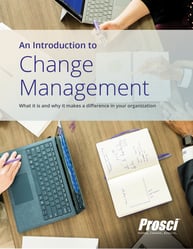
The data is clear: even when organisational changes meet technical requirements and milestones, they can still fail to deliver results and benefits. What’s missing? Change management. Organisations that embrace change management are more likely to achieve project objectives, stay on or ahead of schedule, and stay on or under budget.
Stay up-to-date on our latest blogs, upcoming webinars and cutting-edge research.
You may unsubscribe from our emails at any time. See our privacy policy for more information.
